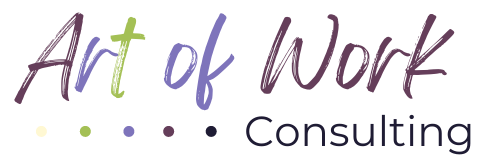Art of Work: an introduction

“Here’s to freedom, cheers to art. Here’s to having an excellent adventure and may the stopping never start.”
― Jason Mraz
Welcome to my blog, “The Art of Work!”
This blog will explore how work of any kind can utilize principles from the arts to maximize and enhance business experiences, relationships, and outcomes. Each blog will explore different concepts related to the arts and put them into the context of the business world.
For the purposes of this blog, the arts will include visual, performing, and literary arts. We may also expand to include the humanities and the liberal arts and explore how those educational areas lend themselves directly to work in business environments. These blogs will employ metaphor as well as real life examples; blend emotional, spiritual, and intellectual exercises and activities; stimulate exploration of creative ideas; and encourage dreaming.
Ready?
During our exploration, we will strive to bring artistic practices into your experience in order to energize areas of your business. My aim is for you to begin to see yourself as an artist. An artist of your own making in the discipline of your choosing.
Why become an artist?
Let’s start with the definition of art to help us clarify how expansive this term can be.
Here’s a definition from Wikipedia:
Art is a diverse range of human activities involving the creation of visual, auditory or performing artifacts (artworks), which express the creator’s imagination, conceptual ideas, or technical skill, intended to be appreciated primarily for their beauty or emotional power.
Okay, so that feels like what we think of as art in the sense of the traditional creative arts, but let’s dig into that a bit.
- Art requires “imagination, ideas, and/or technical skill.”
I imagine you have used one or all of those three qualities in whatever work you do. Imagining a new way of doing something that creates a better outcome; considering new ideas and finding ways to implement them for better effect; becoming better and better at your occupation so that you are more technically adept at whatever you do.
- Works of art art are “appreciated primarily for their beauty or emotional power.”
Well, what you do may not feel beautiful, so let’s look at how that could work. Let’s start with the first part of the definition of “Beauty” from Dictionary.com
Beauty [is] the quality present in a thing or person that gives intense pleasure or deep satisfaction to the mind.
Hmmm. So, can qualities of work provide pleasure and deep satisfaction of the mind? Yes! Not all work is pleasurable, but think about how you feel when you’ve completed a project satisfactorily, made a sale, worked with the team to develop and implement a new idea. You fill in the blanks.
What about the last part of that definition that suggests that art includes an appreciation of “emotional power?” Can work of any type have emotional power? This is one of my favorite topics and I look forward to taking it apart in upcoming blogs, but how about we dip our toe in the water by considering how art affects us emotionally?
We can be moved by a piece of music that evokes a memory or perhaps simply because of the way the instruments or vocals drive or soar or whisper. A painting or a play or a poem that makes us hear or read or see something that causes us to react — either positively or negatively — due to its social, political, historical, religious or spiritual depiction has a momentary, or sometimes a lasting, impact on us. Consider the poem written and read at the inauguration of President Biden after a year of racial and political strife in the midst of a global pandemic. That moving poem, “The Hill We Climb,” by Amanda Gorman, hit Americans in their hearts. That is the emotional power of art! If given a larger audience, art can have a far-reaching impact.
But, can emotional impact and power be present in a professional, non-arts environment? And, if it is present, how does it relate to business outcomes?
Let’s look at a story from my personal experience as an executive in a non-profit staffing organization whose mission is to provide priority job opportunities to individuals with disabilities.
A few years ago an individual (let’s call her “Sarah”) registered with the staffing agency I worked for. Sarah had a physical disability which made it difficult for her to walk, slurred her speech, and caused partial sight loss in one of her eyes. Highly intelligent and a recent doctoral graduate, she struggled to find opportunities for employment outside of the university system. It was never directly discussed, but I can only imagine that biases based on her disability, made her appear as a less than desirable candidate.
Despite these challenges, Sarah showed an incredible positive demeanor and during our interview I found her charming, funny, and absolutely delightful! I felt certain I could help her and set about to do so. I submitted her resume for several promising opportunities, but months later, after several interviews she had not secured a position and was becoming more and more discouraged. We kept at it and ultimately she interviewed for a position during which the hiring manager recognized her incredible talent, intelligence, and energy and offered her the role! She took the position, and though it was a temporary role, she became a star player for her team and was nominated and awarded as a “Employee of the Month” by my organization with the most incredible nomination write-up I’ve ever read.
Was this outcome simply a success story? Sure. Was there emotional impact? On me, without question! On Sarah? Well, after seeing the expression on her face during the surprise awards presentation when she discovered she was not being fired, but was being celebrated — absolutely! Her smile and her tears were emotional, in the best way possible.
This story is an illustration of what can happen in a business context that has emotional power but that also allows for all parties to win! My staffing agency made a great placement which led to a happy client who talked us up and sent more work our way. This client had a wonderful worker who helped them through a critical project. And Sarah had employment which assured her a weekly paycheck and also provided her an opportunity to feel valued in the workplace and led her to pursue rewarding opportunities in other professional environments. As a side note, Sarah, despite her disabilities and inability to even drive herself to the job site, had perfect attendance during that assignment. She was never late and never missed even an hour of work.
The beauty of this story (remembering that storytelling is an art!) is that its value continues to benefit the organization I worked for. This and other stories like it have been told again and again and and have helped the staff stay excited, motivated, and engaged about the work that they do. That’s emotional power in a business setting.
So, we’ve begun our exploration. Thank you for reading my first blog! I’m excited to go deeper on this journey with you. How will you become an artist in your work? What will your masterpiece look like, sound like, feel like? That remains to be seen, but it sure is fun to think about! See you next time.
I hope you will subscribe and share your thoughts, and I look forward to exploring more on this topic in the coming weeks.
